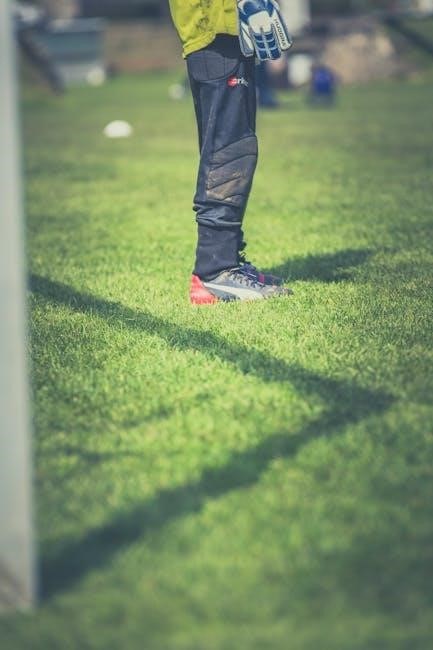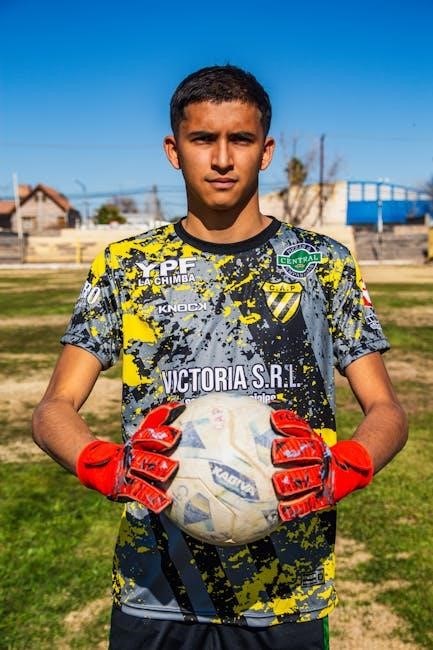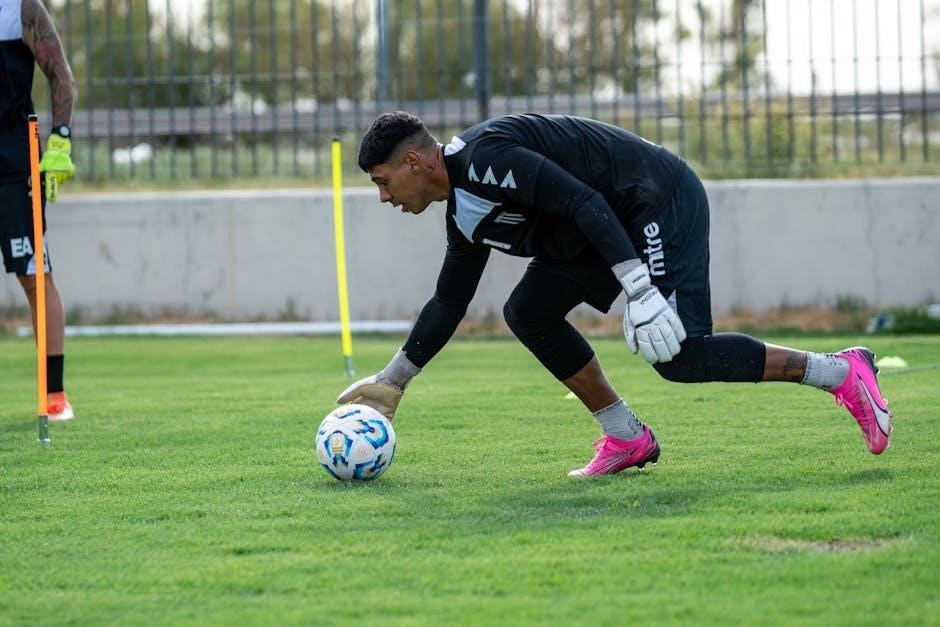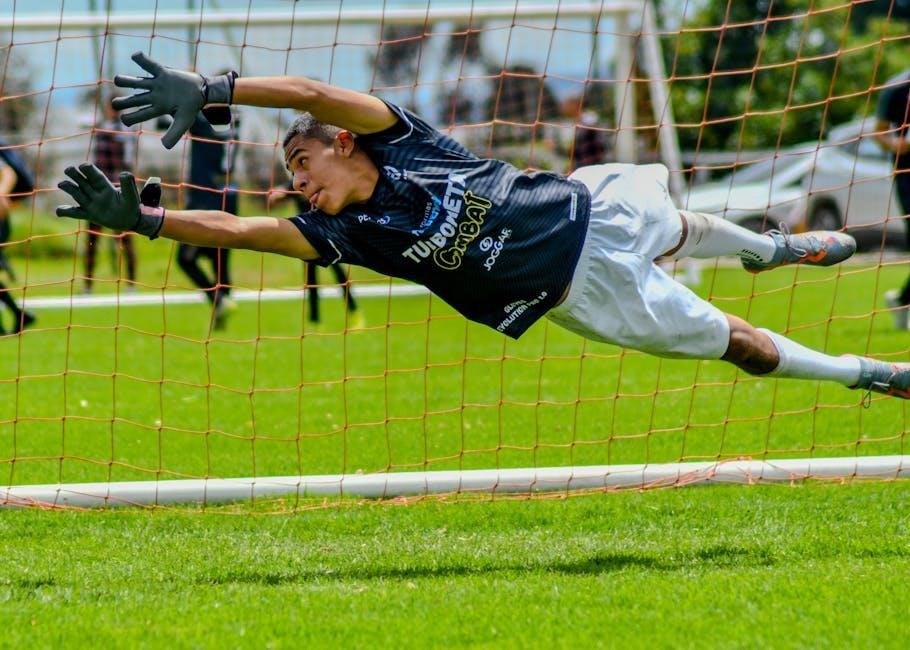Choosing the right soccer glove size is crucial for optimal performance and comfort. This guide helps measure hand circumference, length, and finger support to ensure a perfect fit.

Key Measurements for Sizing
Measure hand circumference, length, and finger spine support to ensure proper fit and performance in soccer gloves.
Hand Circumference Measurement
Measure your hand circumference just below the knuckles, excluding the thumb, to determine your glove size. Use a flexible tape measure or a string to wrap snugly around your hand. Ensure the measurement is not too tight or loose. Compare your measurement to the size chart, where Small typically ranges from 6-7 inches, Medium 7-8 inches, Large 8-9 inches, and X-Large 9-10 inches. Some charts may also include measurements in centimeters for accuracy. Proper fit ensures optimal grip, comfort, and performance. Keep in mind that sizes can vary slightly between brands, so always refer to the specific brand’s sizing guide for the best fit. Accurate measurement is key to selecting gloves that enhance your game without restricting movement.
Hand Length Measurement
Hand length is measured from the tip of the middle finger to the base of the palm. This measurement helps determine the overall fit of the glove, ensuring fingers are not cramped or excessively long. To measure accurately, place your hand flat with fingers extended and use a ruler or tape measure. Typical size ranges for hand length include Small (6.5-7.5 inches), Medium (7.5-8.5 inches), Large (8.5-9.5 inches), and X-Large (9.5-10.5 inches). Some brands may vary slightly, so always consult the specific brand’s sizing chart. Proper hand length ensures the glove’s fingers align naturally with yours, providing comfort and control during play. This measurement, combined with hand circumference, offers a comprehensive fit assessment for optimal performance.
Finger Spine Support Measurement
Finger spine support measurement assesses the length of the fingers to ensure the glove’s fingers align correctly. Measure from the base of the middle finger to the tip, ensuring the glove’s fingers are neither too short nor too long. Proper support prevents excessive material bunching and maintains grip control. Gloves are designed with varying finger lengths to accommodate different hand types. This measurement is crucial for goalkeepers, as it affects ball handling and grip consistency. Combining this with hand circumference and length ensures a tailored fit, enhancing performance and comfort during games. Always refer to the brand’s specific sizing chart for accurate measurements.
Understanding Soccer Glove Size Charts
Soccer glove size charts help determine the best fit by aligning hand measurements with glove sizes, ensuring comfort and performance. Measure hand circumference, length, and finger spine for accuracy.
Adult Soccer Glove Size Chart
Adult soccer glove sizes typically range from Small to XXL, corresponding to specific hand measurements. To determine your size, measure the circumference of your hand just below the knuckles, excluding the thumb. For a snug fit, compare this measurement to the size chart: Small (6-7 inches), Medium (7-8 inches), Large (8-9 inches), and X-Large (9-10 inches). Some brands may offer half sizes or slight variations, so it’s important to refer to the specific brand’s sizing guide. Proper fit ensures optimal grip, flexibility, and comfort during gameplay. If your measurement falls between sizes, consider the activity level and personal preference for a tighter or looser fit. Accurate sizing enhances performance and protects your hands during matches or training sessions.
Youth and Children Soccer Glove Size Chart
Youth and children’s soccer glove sizes are designed to accommodate smaller hands while ensuring proper fit and functionality. Sizes typically range from XXXS to L, with measurements based on hand circumference and finger length. For younger players, measure the hand around the palm, excluding the thumb, and compare to the chart: XXXS (17cm), XXS (18cm), XS (19cm), S (20cm), M (21cm), and L (22cm). Some brands offer age-specific sizing, such as 6-8 years for XS and 9-12 years for S. Proper fit is essential for young goalkeepers to maintain control and confidence. Ensure gloves are not too tight, allowing room for growth and movement. Correct sizing helps prevent discomfort and enhances performance during training and matches.

Factors Influencing the Fit of Soccer Gloves
The fit of soccer gloves is influenced by several key factors, including hand measurements, age, and brand-specific designs. Proper hand circumference and length are crucial for ensuring a snug yet comfortable fit. Youth and children’s gloves are tailored to smaller hands, with sizes ranging from XXXS to L, while adult sizes vary from S to XXL. The thickness of the palm and finger padding also impacts fit, with some goalkeepers preferring tighter gloves for better control and others opting for a looser fit for flexibility. Additionally, the type of material and grip can affect how the gloves feel, with latex palms offering superior grip but requiring precise sizing. Accurate measurements ensure optimal performance and comfort during games. Proper fit is essential for peak performance and protection;
How to Choose the Right Size
Use a size chart, measure hand circumference, and ensure a snug fit for optimal performance. Proper sizing balances comfort and flexibility, boosting confidence during games.
Trying On Gloves for the Best Fit
Trying on gloves is essential to ensure a comfortable and functional fit. When gloves are on, they should feel snug but not restrictive. Check if your fingers have enough room without excessive space. The palm should align well with your hand, and the wrist closure should provide secure support. If possible, try gloves with a ball to assess grip and control. Proper fit enhances performance, so prioritize how they feel during movement. If shopping online, refer to size charts and reviews for guidance. Remember, gloves should slightly extend past your fingertips for optimal protection and dexterity. A well-fitting pair boosts confidence and improves gameplay.
Fit and Performance During Games
A proper fit ensures peak performance during games. Gloves that are too tight may restrict movement, while those too loose can reduce grip and control. The palm should snugly fit your hand, allowing precise ball handling. Finger length should extend slightly past your fingertips for added protection without hindering dexterity. The wrist strap should provide stability, preventing the gloves from shifting during dives or catches. Proper fit enhances grip, allowing better ball control and accuracy. It also reduces the risk of injury by providing adequate cushioning and support. A well-fitting glove boosts a goalkeeper’s confidence, enabling them to perform at their best during critical moments of the game.
Importance of Accurate Sizing
Accurate sizing is essential for optimal performance and comfort in soccer gloves. A proper fit ensures better grip, control, and mobility, crucial for goalkeepers. Ill-fitting gloves can lead to poor ball handling and increased risk of injury. Correct sizing provides adequate cushioning and support, enhancing protection during dives and impacts. It also prevents restrictive movement, allowing goalkeepers to react quickly and effectively. Properly sized gloves boost confidence, enabling goalkeepers to focus on their game without distractions. Ensuring the right fit is vital for both adult and youth players, as it directly impacts their ability to perform at their best. Accurate sizing is the foundation for peak performance and safety in goalkeeping.
Brand Variations in Sizing
Brands like Adidas, Nike, and others may vary in sizing standards, requiring careful comparison. Always check the specific brand’s size chart for accurate measurements and fit.
Adidas Goalkeeper Glove Sizing
Adidas goalkeeper gloves are known for their precise sizing, ensuring optimal grip and comfort. To determine your size, measure your hand’s circumference just below the knuckles, excluding the thumb. Adidas typically offers sizes ranging from 6 to 12, with each size corresponding to specific measurements. For example, a size 7 usually fits hands measuring 7-8 inches in circumference. The brand also provides half sizes for a more tailored fit. Adidas gloves often feature adjustable cuffs and finger protection, which enhance both performance and durability. Proper sizing is essential to maintain dexterity and control during games. Always refer to Adidas’ official size chart for the most accurate fit, as variations may occur between different models and collections.
Nike Goalkeeper Glove Sizing
Nike goalkeeper gloves offer a snug and responsive fit, designed for precision and control; To find your ideal size, measure the width of your palm across the knuckles, excluding the thumb. Nike sizes generally range from 6 to 12, with each size tailored to specific hand dimensions. For instance, a size 8 typically fits palms measuring 8-9 inches in width. Nike gloves often feature innovative technology like textured palms for better grip and adjustable straps for customized comfort. Proper sizing ensures maximum dexterity and support during gameplay. Always consult Nike’s official size chart for accurate measurements, as slight variations may exist between different models and collections to cater to various player preferences and needs.
Other Brand-Specific Sizing
Various brands, such as Adidas, Reusch, and Uhlsport, offer unique sizing systems for goalkeeper gloves. These may differ slightly from one another, so it’s essential to consult the specific brand’s size chart. For example, a size 9 in one brand might not match a size 9 in another. Most brands provide detailed measurements based on hand circumference and length, typically in inches or centimeters. Some brands also offer half sizes or additional features like adjustable cuffs for a more personalized fit. To ensure accuracy, measure your hand according to the brand’s guidelines, as some may include the thumb in their measurements while others exclude it. Always check customer reviews or sizing guides specific to the brand to avoid discrepancies and find the perfect fit for your gloves.

Materials and Grip
Soccer gloves are crafted from high-quality materials to enhance grip, durability, and comfort. The palm is typically made of latex, which provides superior ball control in various weather conditions. Some gloves feature foam padding for added cushioning and shock absorption. Synthetic materials are also used for lightweight and breathable designs. The backhand often includes flexible, breathable fabrics to regulate temperature and allow natural hand movement. For wet conditions, certain gloves incorporate textured latex to improve grip. Additionally, finger spines are integrated into some models to prevent hyperextension during dives. The choice of materials directly impacts performance, making it essential to select gloves suited to your playing style and environmental conditions. Proper care of these materials ensures longevity and maintains their grip and functionality over time.

Maintenance and Care Tips
Proper maintenance ensures your soccer gloves remain in optimal condition. After each use, rinse the palms with water to remove dirt and sweat, avoiding harsh chemicals. Allow gloves to air dry naturally, as heat can damage the latex. Store them in a cool, dry place to prevent moisture buildup. For tougher stains, gently scrub with a mild soap solution. Conditioning products can extend the life of the latex, enhancing grip. Regularly inspect for wear and tear, especially on the fingertips and palms. Replacing gloves when necessary ensures performance consistency. By following these care tips, you can prolong the durability and effectiveness of your gloves, maintaining their grip and support throughout the season.

Leave a Reply
You must be logged in to post a comment.